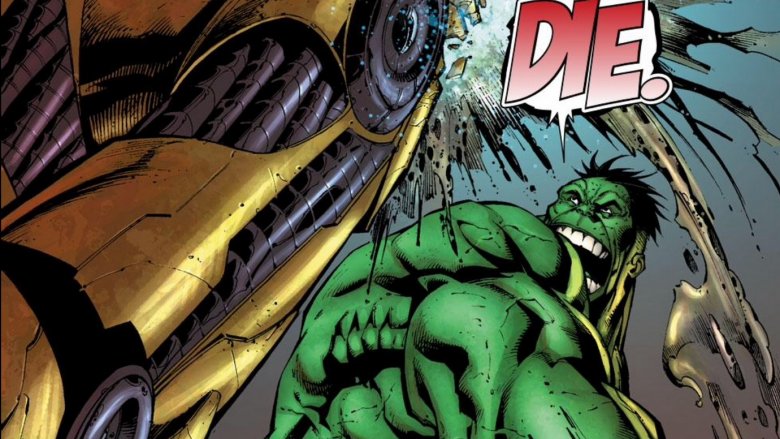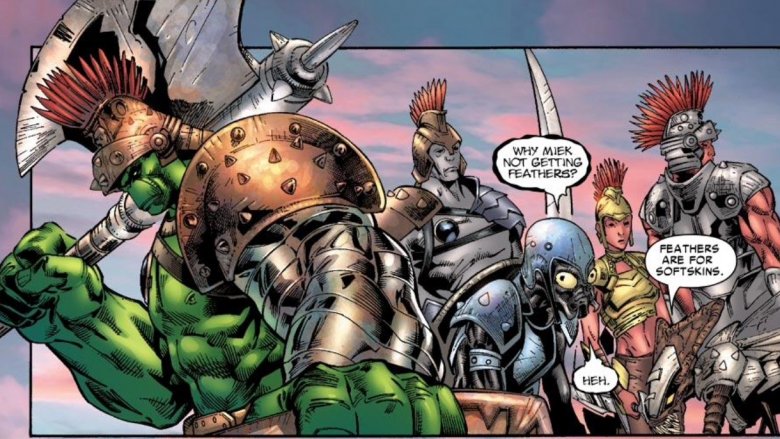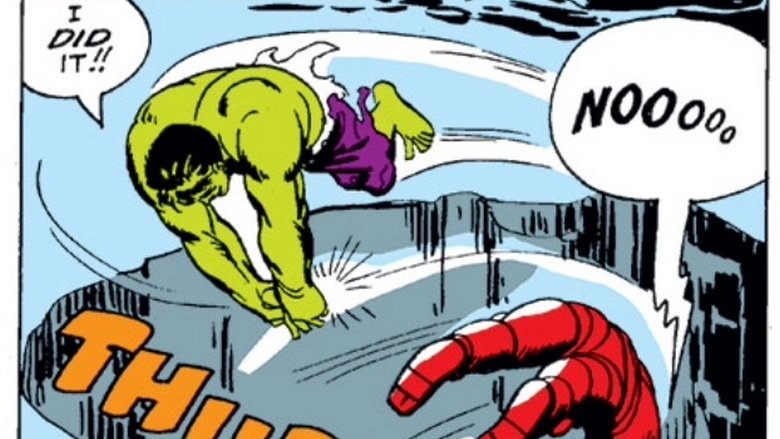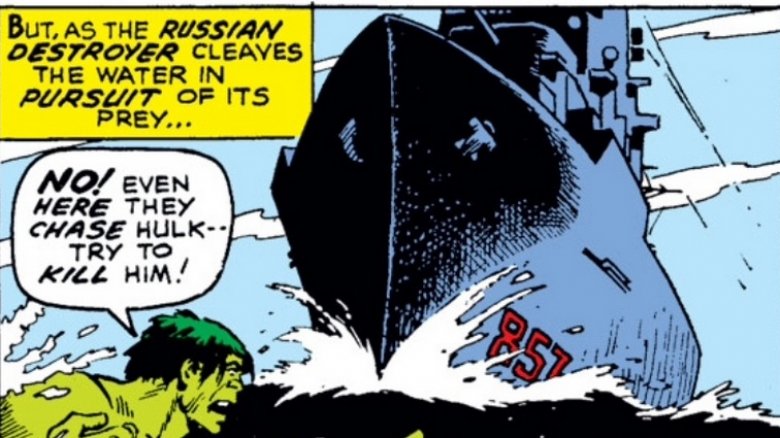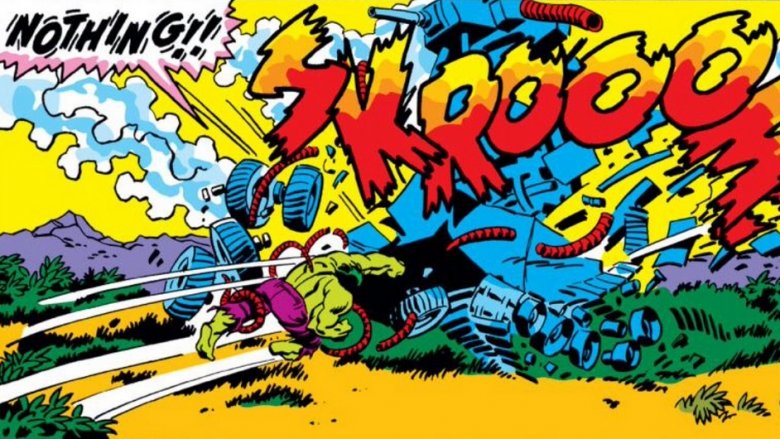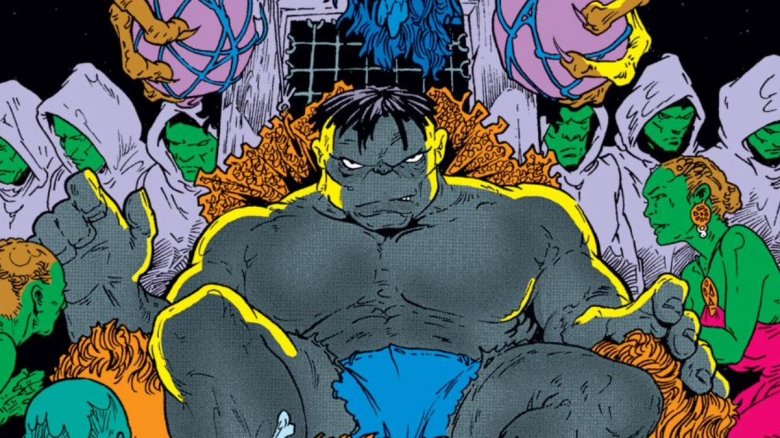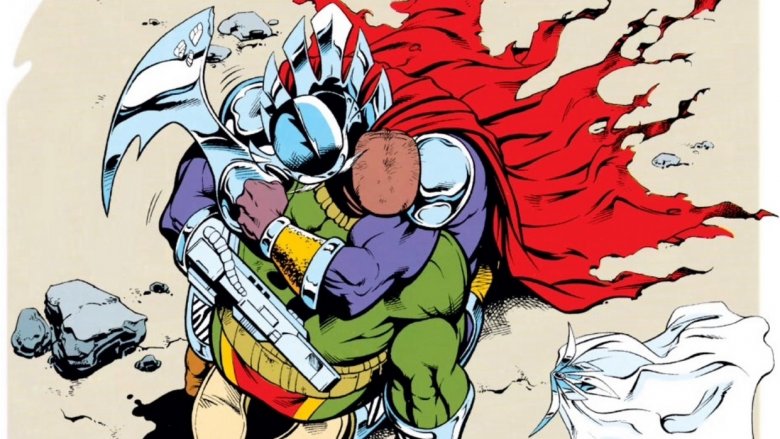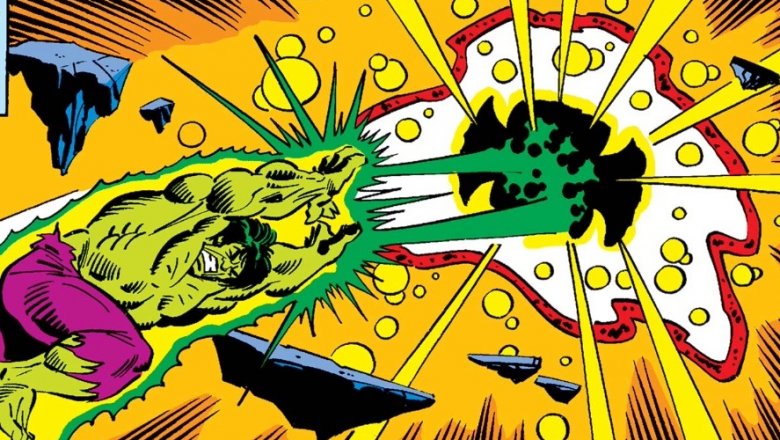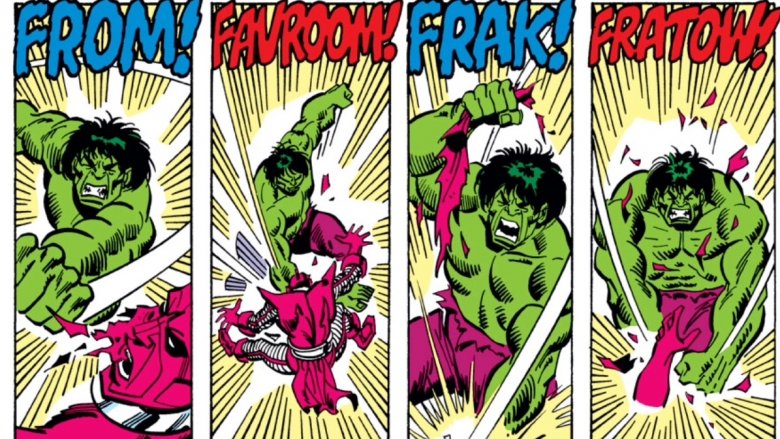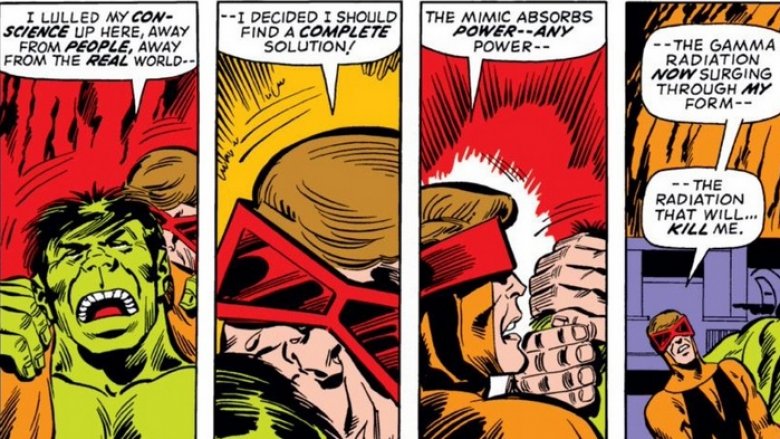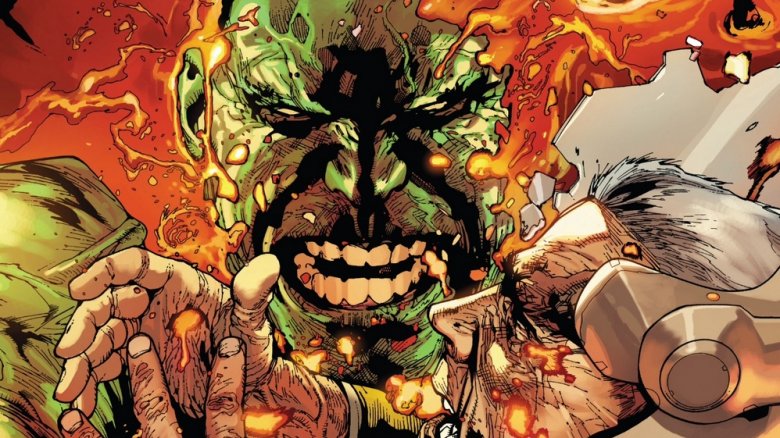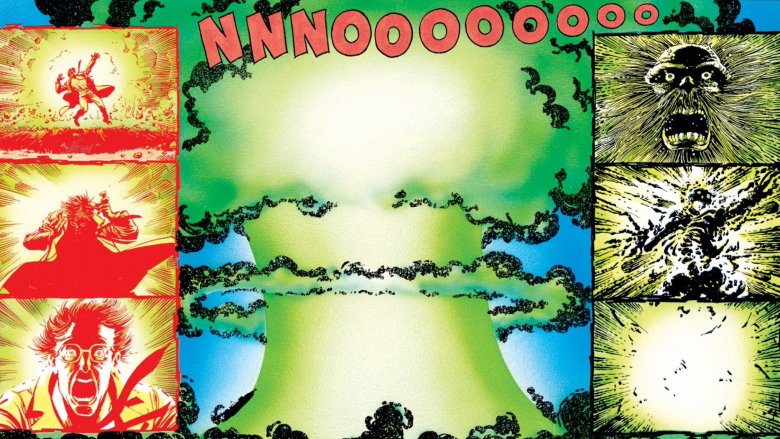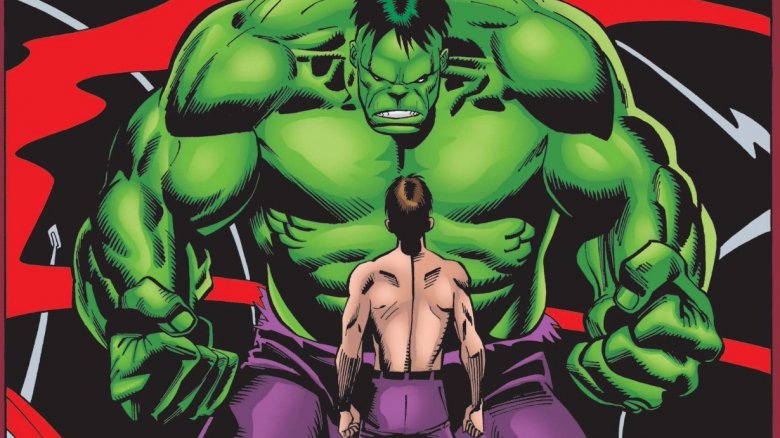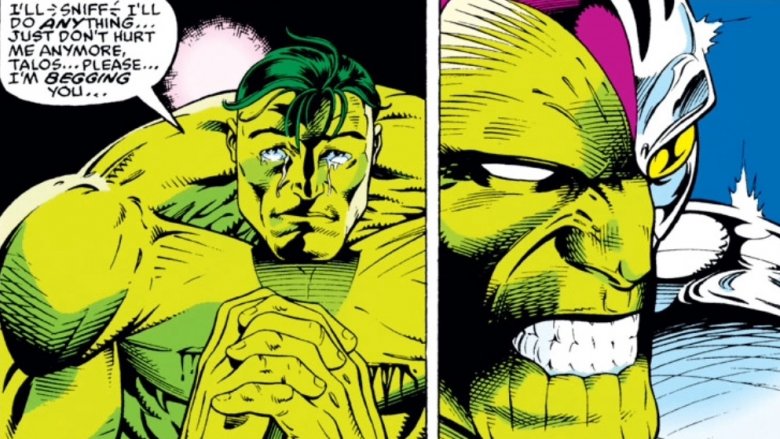Every Time The Hulk Was Forced To Take A Life
Superheroes don't like to kill. Sure, there are darker and more violent types who'd disagree, like Wolverine or the Punisher, but they tend to be the exceptions that prove the rule.
Even in the case of a relatively wild and unpredictable superhero like the Incredible Hulk, killing has never been an easy option. Over the years the intelligence level and personality traits of Bruce Banner's alter ego have changed many times, but even at his dumbest and least cooperative, the Hulk wouldn't consciously kill unless he felt he had no other choice.
But that doesn't mean it's never happened — and a time or two, he seemed to actually enjoy it. Here's every time the Hulk was forced to take a life.
Hulk and the Warbound of Planet Hulk
Greg Pak's "Planet Hulk" story was one of the most consequential Hulk tales of the franchise's history. It was adapted into an animated film, helped inspire the events of Thor: Ragnarok, and paved the way for the company-wide Marvel event World War Hulk.
The Hulk is tricked into a spaceship and exiled from Earth by a secret cabal of superheroes who deem him too much of a threat. His ship crashes on Sakaar, a place where space age technology meets the look and tyranny of the Roman Empire. Hulk is captured and made a gladiator as soon as he arrives.
Bound with obedience disks that could fry his brain should he struggle against them hard enough, the Hulk is forced to kill other gladiators. As early as his first training exercises in The Maw — the proving grounds where Hulk and other gladiators train before fighting for the pleasure of the crowds — he kills other slaves. He kills one of the sisters of his future ally Sym, from an alien race called the Brood first made famous in Uncanny X-Men. In the Arena itself he kills the comrades of Korg, the rocky warrior who was given the voice of director Taika Waititi in Thor: Ragnarok. Later, leading a revolt against the tyrannical Red King, the Hulk has no choice but to kill his enemies on the field of battle, including eventually the Red King himself.
Hulk hates robots
Instead of Red Kings, the earliest example of Hulk being forced to kill an opponent finds him dispatching a red robot's secret passenger in 1964's Tales to Astonish #61.
Bruce Banner creates the robot to withstand punishment from even an atomic bomb blast. A faceless opportunist steals the robot right before it's to be tested in hopes of selling it to the highest bidding foreign nation (though a robot, the machine is conveniently humanoid shaped and has enough room to fit a human being). Not wanting to waste the opportunity to test the robot, the thief drives the robot onto the test range. Its hull survives explosive blasts and its arms bench-press tanks.
When the Hulk shows up, the thief tests the robot some more. He figures if he can defeat the Hulk with the suit, he can ask whatever price he wants for the thing. Indeed, the Hulk pounds on the suit and throws it, but isn't able to make a dent. Cornered by the robot, the Hulk knocks the robot and its wearer down a bottomless pit. We never learn the identity of the thief.
Banner apparently retrieves the suit at one point, because it appears in 2009's Incredible Hulks #601 when he uses it to help train his super-powered son Skaar. Presumably, Banner gave the interior a good scrubbing before wearing it himself.
Hulk vs. The Commies
More than villains like the Abomination or the Leader, more than heroic rivals like Wolverine or Thor, the Hulk's most constant sparring partner is the military.
Usually when it comes to the question of whether or not Hulk is actually killing the soldiers hounding him, the creators choose one of two directions. Either they're ambiguous about the fates of the soldiers, or they go the old '80s G.I. Joe cartoon route and show all the jet pilots and tank crews jumping out or ejecting just in time.
There was no ambiguity in 1971's Incredible Hulk #145. Pursued by a Soviet destroyer, the Hulk latches onto the ship's hull and pulls it deep enough into the ocean for the pressure to crush the "special munitions" (presumably nuclear weapons) the destroyer carries, causing them to explode. There are no lifeboats, no shocked sailors bobbing on the waves, no one saying in translation brackets that they can't believe they survived such a vicious attack. Likely such fictional carnage was considered acceptable in an early '70s Marvel comic only because the victims were Soviets. As further proof, on the next page we learn that the power of Hulk's passing through the water is so powerful that it causes tidal waves to hit unnamed cities "to the east." No one is shown dying, but we see buildings topple and civilians running for their lives.
Hulk destroys the War-Tower of Draxon
A year before he sank the Soviet destroyer, the Hulk killed the despotic ruler General Draxon.
Draxon rules over the fictional eastern European nation of Morvania. He initially tries to recruit the Hulk, but when Hulk turns against him, Draxon hunts the green goliath in his huge, mechanized "War-Tower of Draxon." The Hulk destroys the metal monstrosity with one colossal punch, killing Draxon in the process.
Incredible Hulk #134 was also noteworthy for its tone and theme. The Hulk meets Morvanian citizens who believe him to be the mythic Golem, a creature built from clay to serve its maker. Along with despot-killing action, the story has a few quiet moments with panels without dialogue or narration, a rare thing in a 1970 Marvel superhero comic.
Hulk enjoys sects and violence on K'ai
Early in his 12-year run on the title, writer Peter David ended Incredible Hulk #345 with the hero presumably killed by a blast from a gamma bomb detonated by his nemesis the Leader. Two issues later, the Hulk turned up working for a mob boss in Las Vegas, but without any explanation as to how he survived the blast, how he got to Las Vegas, or why he wasn't changing back to Bruce Banner.
Fans kept guessing for a few months until Incredible Hulk #351 and #352, a two-issue flashback that revealed how alien wizards from K'ai — a microscopic world Hulk visited before — were monitoring the Hulk and transported him to K'ai before the Leader could kill him. Since his last visit to K'ai, a religion had sprouted up based on the Hulk, and K'ai had suffered from its fanaticism. The wizards wanted the Hulk to dethrone the ruler of this religion: The Grand Inquisitor. The Hulk — now a gray-skinned version with fewer moral scruples than earlier versions — agreed under the condition that the wizards use their powers to suppress his human half so he could be Hulk all the time.
In Incredible Hulk #352, the Hulk defeats the Grand Inquisitor and has him tortured until he admits to his followers that the Hulk was the true Hulk. He begs for the Hulk to bless him, which the Hulk does with a dismissive wave of his hand, and then the Grand Inquisitor dies from his torture.
The death of Trauma
The Hulk hasn't had to pay much of a price for most of the lives he's taken, but the hero continues to suffer for the death of Trauma.
The Hulk first locked horns with Trauma in Incredible Hulk #394, when the Hulk fought him to stop him from killing Atlanta, the Hulk's ally in The Pantheon (a paramilitary organization filled with super-powered soldiers named after figures of Greco-Roman myth). Trauma's true name was Trow-Ma, and he was the prince of an interstellar empire known as the Troyjans. He was obsessed with Atlanta and determined to make her his bride.
After Trauma kidnaps Atlanta in Incredible Hulk #413, the Hulk and his Pantheon comrades race to the stars to save her. Recruiting the Starjammers and the Silver Surfer along the way, the assembled heroes fight Trauma and his more powerful father Armageddon in Incredible Hulk #416. The Hulk ends the battle by slamming Trauma against a wall and impaling him on his own armor. Armageddon swears vengeance on the Hulk, and has tried and failed a number of times to achieve it.
One of Armageddon's more memorable attempts at retribution was in one of Peter David's final issues of the series, Incredible Hulk #464. Armageddon forces the Hulk into a machine which he believes will harness the Hulk's power to resurrect Trauma. The device succeeds, but Hulk intentionally overloads Trauma with his power, killing him a second time.
Hulk kills the Galaxy Master
Trauma wasn't the first space villain the Hulk killed, and he wasn't close to being the most powerful.
In Incredible Hulk #270, recruited by former foes like Aquon and the Night Crawler (nope, not the blue guy from X-Men, different dude), the Hulk kills a giant amoeba-looking thing called the Galaxy Master. With Galaxy Master's pawn Abomination defeated by the Hulk, the godlike creature uses its own powers to try to destroy the man-monster. For some reason, Galaxy Master chooses gamma rays — the same energy that created the Hulk — to attack the hero, and while he does some damage, the Hulk ultimately absorbs the power and redirects it back at the Galaxy Master, destroying it.
Hulk smashes the High Evolutionary's armor
Another cosmic character the Hulk killed was the High Evolutionary in Incredible Hulk #266, though he hadn't meant or cared to. It was, in fact, the Evolutionary himself who chose an option a few others have selected: suicide by Hulk.
Wanting to die but unable to because he's trapped in his own godlike armor, the High Evolutionary provokes the Hulk into attacking him again and again. Finally, the Hulk cracks the Evolutionary's armor and the strange, enigmatic being dissolves into sludge. (He'd eventually recover.)
The death of Mimic
In Incredible Hulk #161, Mimic unintentionally leads the Hulk to the secret lab where Hank McCoy, a.k.a. the Beast, is trying to treat him. Mimic once had the ability to copy the powers of others, but unfortunately his power morphed into something that didn't simply copy, but leeched the power from super-powered and normal people alike, killing them if it went on for too long. As Hank McCoy treats Mimic, this power reaches out and finds the Hulk, weakening him and drawing him to the lab.
Beast tries to fight the Hulk off, but the Hulk is much too powerful. Mimic decides that if he's powerful enough to suck the power out of the Hulk without his knowledge, he's clearly too dangerous to live. Mimic jumps into the fray, hoping to leech not only the Hulk's powers, but the radiation that fuels them. He succeeds and, inexplicably not absorbing Hulk's immunity to the radiation along with everything else, quickly succumbs and dies.
The death of Colin Thirty-Three
The Quintronic Man — the robot so powerful it needed five people to control it (like Voltron, but without the cats or the appeal) — first appeared in 1977's Incredible Hulk #213. Their reunion would have to wait 35 years for 2012's Indestructible Hulk #3.
This time we learn Quintronic Man is controlled by the villainous group A.I.M., and a man named Colin Thirty-Three pilots the device. The original Quintronic Man crew members are long dead. Ghoulishly, however, Colin Thirty-Three keeps the skeletal corpses of four of the other operators in the robot as if they were still kicking.
Colin Thirty-Three tries to kill the Hulk by submerging him in molten lava, but is surprised when the Hulk survives the heat and crashes through the Quintronic Man armor, exposing Colin to the lava and killing him.
Birth of the Hulk, Death of the Maestro
One of the most poetic deaths the Hulk has doled out was to himself.
In the miniseries Incredible Hulk: Future Imperfect, the Hulk travels forward in time to learn that not only has a super-powered madman taken over what little remains of humanity, but that the despot in question is his future self. Calling himself the Maestro, the Hulk survived various apocalypses; though the white hair and beard make him look elderly, the radiation in the atmosphere rendered him stronger than ever.
Unable to match either the Maestro's viciousness or his strength, the Hulk defeats his future dystopian self by using the same time machine that brought him into the future to send the Maestro into the past. Specifically, he sends the Maestro to the very moment the gamma bomb that changed Bruce Banner into the Hulk erupted. The only difference is that Maestro is standing just next to the bomb as it goes off.
His own worst enemy
Future Imperfect is neither the first nor the last example of the Hulk dealing lethally with himself. Often in the rare cases when the Hulk kills, it is himself — or part of himself — that dies.
Along with Future Imperfect, there's Incredible Hulk: The End, whose climax sees the savage, childlike Hulk smothering Bruce Banner's identity because he fears Banner will find a way to kill both of them the next time he emerges. When the Hulk finds a way to physically separate himself from Banner with a little help from Doctor Doom, the green guy holds Banner prone while a gamma bomb blast rips him to pieces in 2012's Incredible Hulk #7. In Incredible Hulk #299, after being manipulated by the mystic villain Nightmare, Banner commits a psychic suicide that leaves a rampaging psychic Hulk to pursue Nightmare through his own dimension, as well as a mindless Hulk in the physical world to tear through New York and most of its heroes.
It's a testament to the self-loathing that defines the Hulk/Banner dichotomy that usually when Hulk decides to end somebody, it's himself.
Talos gets a pass
As much as we expect superheroes to not kill, a comic from the '90s enraged fans because the Hulk chose to stay his hand.
In Incredible Hulk #419, after attending the wedding of Rick Jones and Marlo Chandler, the disgraced skrull warrior Talos the Tamed attacks the Hulk in hopes that the Hulk will give him an honorable death.
But unlike the suicide-by-Hulk cases of Mimic and the High Evolutionary, the Hulk Talos faces is one of the more intelligent versions and not as easy to manipulate. Not to mention it's only been three issues since the Hulk killed Trauma, and he isn't eager for a fresh helping of guilt.
So, rather than kill Talos, the Hulk gives up. Though clearly not hurt badly, the Hulk begs for mercy from Talos. The skrull sees the ruse for what it is, but is so insulted by it that he refuses to continue to fight someone who would use such a pathetic tactic. Though he survives the fight, his fellow Skrulls have watched him go toe to toe with the Incredible Hulk. When he returns to his ship, Talos is welcomed by admiration he hasn't enjoyed in ages.
The creative team of Incredible Hulk didn't receive as friendly a response. They weathered a torrent of angry mail from proud fans who couldn't bear to see their favorite good guy do something so "wimpy," even if it was clearly a fake-out.
